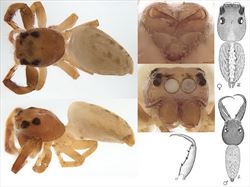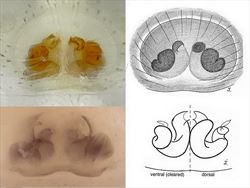
Examples of live female (T) and male (B) Canama specimens
Illustrator (and ©) R. Whyte

Aspects of the general morphology of Canama
Illustrators (and ©) B.J. Richardson (CSIRO), M. Żabka (diag.) (QMB)

Palp morphology of Canama
Illustrators (and ©) R. Whyte (L), M. Żabka (diag.) (QMB)

Epigyne morphology of Canama
Illustrators (and ©) R. Whyte (TL), B.J. Richardson (BL) (CSIRO), M. Żabka (diag.) (QMB))
Canama Simon, 1903
Taxonomy
Canama, found in the Oriental and Australian Regions, has one described Australian species: Canama hinnulea and at least one known undescribed species. It is also possible Bathippus kochi is a misplaced Canama, having a male palpal organ identical to Canama hinnulea but slightly differing chelicereal dentition (Whyte unpubl.). Further information on the genus and described species can be found in Richardson and Żabka (2017) and Whyte and Anderson (2017).
Description
Canama is a medium-sized, powerful-looking spider, with a body length ranging from 7 to 9 mm. The carapace is high in profile, highest at the posterior lateral eyes. The head, viewed from above, is pear-shaped, widest behind the posterior lateral eyes. The abdomen is elongate-ovate. Males and females are quite different in appearance. The somewhat slender adult male has a cephalothorax wider than its abdomen and enlarged chelicerae. The female has an abdomen as wide as, or wider than its cephalothorax and short chelicerae. The posterior lateral eyes are on distinct tubercules and the posterior median eyes are close to the posterior lateral eyes. The males tend to be dark brown with white markings, while the females are lighter brown with white markings. The colours fade in preserved specimens. The chelicerae have a single bicuspid retromarginal tooth (fissident) with two teeth on the promargin. In the male both the paturon and the fang are greatly extended. Legs do not differ greatly in length.
The male’s palp has a long, slender embolus forming an anticlockwise spiral on the distal edge of the tegulum, reaching about halfway up the cymbium. The tegulum is rounded without a proximal lobe. The short, slender, retro-lateral tibial apophysis has a hooked end.
The female has two epigynal atria with ‘C-shaped’ sclerotised guides. The insemination ducts are short and convoluted, arising from the centres of the atria and moving rearward (posteriorly) to join sausage-shaped spermathecae which extend well past the lateral margins of the guides.
Biology
Canama is found on foliage in rainforest.
Distribution
Canama hinnulea is found in coastal Queensland, north of Gladstone. Other species are found in Indonesia and Papua New Guinea.
References
Davies, V.T. & Żabka, M. 1989, Illustrated keys to the genera of jumping spiders (Araneae: Salticidae) in Australia. Memoirs of the Queensland Museum 27, 189-266.
Richardson, B.J. & Żabka, M. 2017. Salticidae. Arachnida: Araneomorphae. Canberra, Australian Faunal Directory. Australian Biological Resources Study, at https://biodiversity.org.au/afd/taxa/SALTICIDAE.
Whyte, R. & Anderson, G. 2017. A Field Guide to Spiders of Australia. CSIRO Publishing: Clayton.
* The information sheet should be interpreted in the context of the associated diagrams and photographs. Diagrams explaining anatomical terms can be found in the ‘Salticidae’ pictures at the beginning of the list of genera.